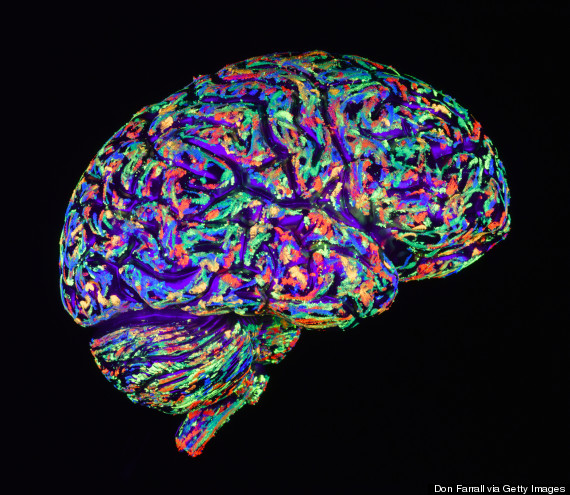Week 7 | Neuroscience + Art
While
studying Art History back in high school, I often noticed that some of the most
talented and creative artists suffered either from a brain disorder or some
drug addiction such as LSD (Vesna). Artist Katherine Sherwood, for example, was
44 when her brain suffered a hemorrhage in its left hemisphere. Previously,
Sherwood’s art was fairly linear, controlled, and used dull colors. After the paralysis of her
dominant hand however, her art style changed and it became more free-form,
natural, and vibrant (Sohn).
 |
| Sherwood's art before hemorrhage (Neuroskeptic) |
 |
| Sherwood's art after hemorrhage (Neuroskeptic) |
Partial
damage to the parietal lobe, the area of the brain that controls spatial
recognition, influenced this sudden change in style (Gardner 324). Another
example portraying the essential relationship between brain function and art is
Georgia O’Keeffe, known for her paintings during a migraine attack. Normally, O’Keeffe
drew sensual and vibrant paintings of flowers. During an attack though, her
artwork drastically changed into distorted shapes and abstract visual illusions
due to her hypersensitivity to light and hallucinations (Podoll).
Furthermore, new advances in technology allow us to scan the
neurons in our brains, opening up a new area of Neuroscience art that blends in
with last week’s BioTech Art. With fMRI and PET Scans, artists and scientists
are able to see what areas of the brain light up when humans perform certain
functions (Frazzetto and Anker).
 |
| fMRI image of the brain's active areas when it is viewing art (Brooks) |
This “brainbow” of colors is certainly my
favorite artwork related to neuroscience, and I can’t wait to see this field
expand as the brain learns more and more about itself.
Source:
Brooks, Katherine. "It Turns Out Your Brain Might Be Wired To
Enjoy Art, So You Have No Excuses." The Huffington Post.
TheHuffingtonPost.com, 20 June 2014. Web. 21 May 2017.
Frazzetto, Giovanni, and Suzanne Anker. "Neuroculture." Nature
Reviews Neuroscience 10.11 (2009): 815-21. Web.
Gardner, Howard. Art, Mind and Brain: A Cognitive Approach
to Creativity. New York: Basic, 1998. Print.
Kruschewsky, Gabriela. "There's A Glow-In-The-Dark Beach In
The Maldives. Yes, Really." The Huffington Post.
TheHuffingtonPost.com, 14 May 2014. Web. 14 May 2017.
Neuroskeptic. "How A Stroke Changed Katherine Sherwood's
Art." Neuroskeptic. N.p., 15 Apr. 2012. Web. 21 May 2017.
Podoll, Klaus. "Georgia O'Keeffe (1887-1986)." Http://www.migraine-aura.com/content/e24966/e22874/e23241/index_en.html.
Migraine Aura Foundation, 25 Mar. 2005. Web. 21 May 2017.
Sohn, Emily. "After Brain Damage, the Creative Juices Flow
for Some." Los Angeles Times. Los Angeles Times, 20 May 2011.
Web. 21 May 2017.
Vesna,
Victoria. Lecture. “Conscious / Memory (Part 3).” 16 Nov 2012. http://www.youtube.com/watch?feature=player_embedded&v=E5EX75xoBJ0

Comments
Post a Comment